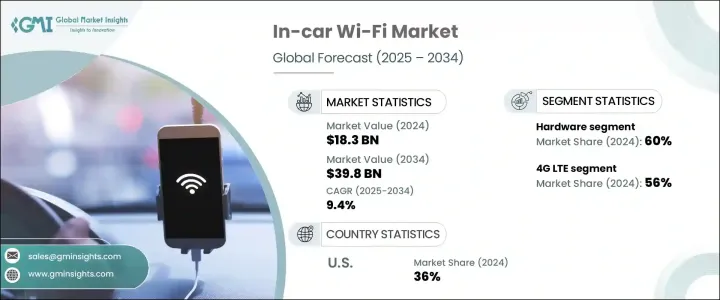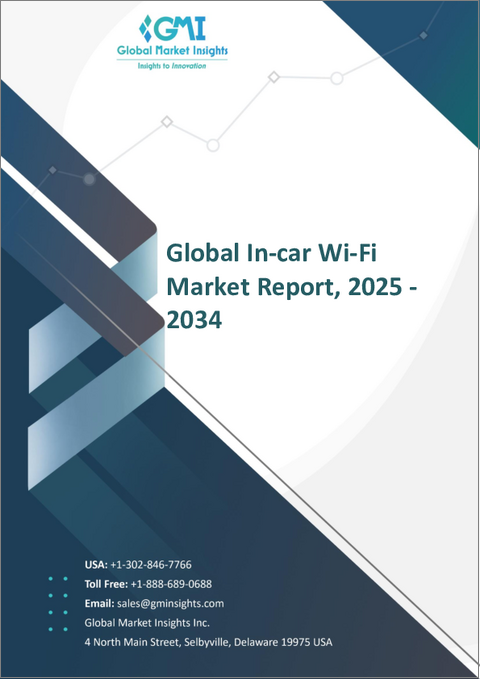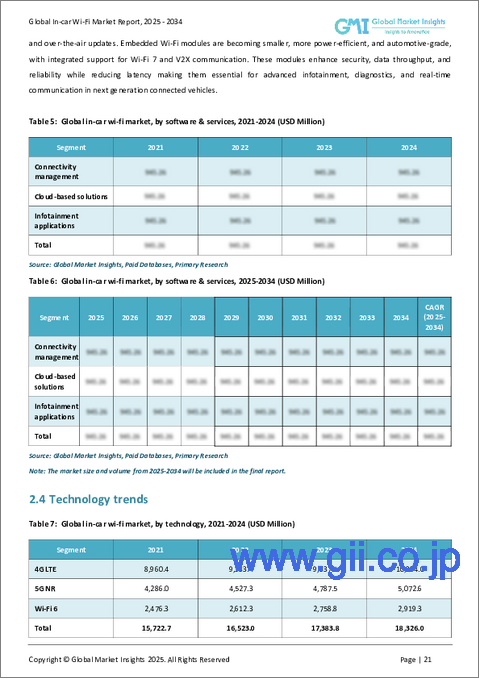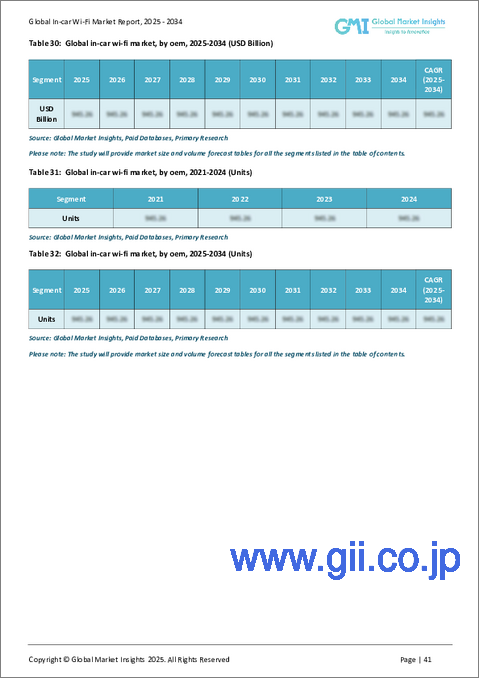|
|
市場調査レポート
商品コード
1708137
車載Wi-Fiの市場機会、成長促進要因、産業動向分析、2025年~2034年の予測In-car Wi-Fi Market Opportunity, Growth Drivers, Industry Trend Analysis, and Forecast 2025 - 2034 |
||||||
カスタマイズ可能
|
|||||||
| 車載Wi-Fiの市場機会、成長促進要因、産業動向分析、2025年~2034年の予測 |
|
出版日: 2025年03月05日
発行: Global Market Insights Inc.
ページ情報: 英文 190 Pages
納期: 2~3営業日
|
全表示
- 概要
- 目次
世界の車載Wi-Fi市場は2024年に183億米ドルに達し、2025年から2034年にかけてCAGR9.4%で成長すると予測されています。
シームレスな接続性、リアルタイムのナビゲーション、外出先でのエンターテインメントに対する需要の高まりが、この成長に拍車をかけています。消費者は、インフォテインメント、ナビゲーション、クラウドベースのアプリケーションのために、自動車が高速インターネットアクセスを提供することを期待しており、車載Wi-Fiは現代の自動車にとって重要な機能となっています。自動車メーカーは、先進的なコネクティビティソリューションを自動車に組み込むことでこれに対応し、ユーザーが運転中も接続を維持できるようにしています。

5GとLTEネットワークの急速な普及は、市場の拡大をさらに加速し、接続速度を向上させ、待ち時間を短縮しています。スマートカーの台頭により、クラウドベースの診断、無線ソフトウェアアップデート、V2X(Vehicle-to-Everything)通信が不可欠な機能となりつつあり、いずれも信頼性の高い車内インターネットアクセスを必要としています。この動向は、デジタル体験が消費者の満足度に極めて重要な役割を果たす、自動車業界を再構築しつつあります。電気自動車(EV)や自律走行技術の普及拡大も市場成長に寄与しています。これらの自動車は、効率的な運行と安全性向上のために継続的なインターネット接続に大きく依存しているからです。さらに、インテリジェント交通システム(ITS)をサポートする規制の義務化によって、自動車メーカーは車載Wi-Fiソリューションを車両に装備するようになり、新たな規格への準拠が確実になっています。
| 市場範囲 | |
|---|---|
| 開始年 | 2024年 |
| 予測年 | 2025年~2034年 |
| 開始金額 | 183億米ドル |
| 予測金額 | 398億米ドル |
| CAGR | 9.4% |
車載Wi-Fi市場は、ハードウェアとソフトウェア&サービスの2つの主要セグメントに分類されます。ハードウェア分野は、Wi-Fiモジュール、ルーター、アンテナなどの堅牢なコンポーネントの需要に牽引され、2024年の市場シェアの60%を占めました。相手先商標製品メーカー(OEM)は、車両にWi-Fiホットスポットを内蔵しており、中断のない接続を提供できる高性能ハードウェアが必要とされています。高度なチップセットとモデムは、5GやV2X通信のような次世代技術をサポートし、優れたユーザー体験を確保する上で重要な役割を果たしています。自動車のコネクテッド化が進むにつれ、メーカーは進化する消費者の期待に応えるため、最先端の車載ハードウェアに多額の投資を行っています。
技術的な観点から、車載Wi-Fi市場は4G LTE、5G NR、Wi-Fi 6に区分されます。2024年時点では、4G LTEが56%と最大の市場シェアを占めており、2034年まで大きな存在感を維持すると予想されます。4G LTEの広範な採用は、ストリーミング、ナビゲーション、その他の車載サービスのためのインターネットアクセスを提供する際の、その広範なカバレッジ、手頃な価格、信頼性に起因しています。5Gはまだ初期段階にあるものの、その展開は拡大し、高度な車載アプリケーション向けに超低遅延かつ高速な接続性を提供すると予想されます。しかし、4G LTEは確立されたインフラであり、5Gと比較して費用対効果の高い実装であるため、自動車メーカーにとっては依然として支配的な選択肢です。
北米は、堅調な自動車セクター、車載接続に対する高い消費者需要、5Gの普及が牽引し、2024年の車載Wi-Fi市場のシェアは36%で首位に立ちました。大手自動車メーカーはWi-Fiホットスポットを内蔵したモデルを発売しており、通信プロバイダーはこの増加傾向をサポートするためにネットワークインフラの拡張を続けています。ライドシェアリングサービス、自律走行車、車両管理システムの拡大とともに、車両へのIoT統合が進んでいることが、車載Wi-Fiソリューションの需要をさらに高めています。コネクティビティが現代の運転体験に不可欠な要素となるにつれ、市場は今後数年で大幅な成長を遂げると思われます。
目次
第1章 調査手法と調査範囲
第2章 エグゼクティブサマリー
第3章 業界洞察
- 産業エコシステム分析
- サプライヤーの状況
- 半導体・部品メーカー
- 通信会社
- 自動車Tier1サプライヤー
- 自動車部品メーカー
- ソフトウェア・プラットフォームプロバイダー
- 利益率分析
- 価格動向
- テクノロジーとイノベーションの展望
- 特許分析
- 主要ニュース&イニシアチブ
- 規制状況
- 影響要因
- 成長促進要因
- コネクテッドカーの需要増加
- 5G・LTEネットワークの拡大
- ストリーミングサービス、オンラインゲーム、スマートアシスタントの利用の増加
- 車載IoTの技術的進歩
- 業界の潜在的リスク・課題
- 一貫した信頼性の高いインターネット接続が課題
- データセキュリティとプライバシーに関する懸念
- 成長促進要因
- 成長可能性分析
- ポーター分析
- PESTEL分析
第4章 競合情勢
- イントロダクション
- 企業市場シェア分析
- 競合のポジショニングマトリックス
- 戦略展望マトリックス
第5章 市場推計・予測:コンポーネント別、2021年~2034年
- 主要動向
- ハードウェア
- Wi-Fiルーター
- 組み込みモジュール
- OBD-IIデバイス
- アンテナ・レシーバー
- ソフトウェア&サービス
- コネクティビティマネジメント
- クラウドベースのソリューション
- インフォテインメントアプリケーション
第6章 市場推計・予測:技術別、2021年~2034年
- 主要動向
- 4G LTE
- 5G NR
- Wi-Fi 6
第7章 市場推計・予測:2021~2034年、車両別
- 主要動向
- 乗用車
- ハッチバック
- セダン
- SUV車
- 商用車
- 小型商用車(LCV)
- 中型商用車(MCV)
- 大型商用車(HCV)
第8章 市場推計・予測:流通チャネル別、2021年~2034年
- 主要動向
- OEM
- アフターマーケット
第9章 市場推計・予測:地域別、2021年~2034年
- 主要動向
- 北米
- 米国
- カナダ
- 欧州
- 英国
- ドイツ
- フランス
- イタリア
- スペイン
- ロシア
- 北欧
- アジア太平洋
- 中国
- インド
- 日本
- 韓国
- ニュージーランド
- 東南アジア
- ラテンアメリカ
- ブラジル
- メキシコ
- アルゼンチン
- 中東・アフリカ
- UAE
- サウジアラビア
- 南アフリカ
第10章 企業プロファイル
- AT&T
- Bosch Mobility
- Broadcom
- Cisco Systems
- Continental
- Denso
- Ericsson
- Harman International
- Intel
- LG Electronics
- Lytx
- NVIDIA
- NXP Semiconductors
- Panasonic
- Qualcomm
- Samsung Electronics
- u-blox
- Veniam
- Verizon Communications
- Vodafone
The Global In-Car Wi-Fi Market reached USD 18.3 billion in 2024 and is expected to grow at a CAGR of 9.4% between 2025 and 2034. The increasing demand for seamless connectivity, real-time navigation, and entertainment on the go is fueling this growth. Consumers expect vehicles to offer high-speed internet access for infotainment, navigation, and cloud-based applications, making in-car Wi-Fi a crucial feature in modern automobiles. Automakers are responding by integrating advanced connectivity solutions into their vehicles, ensuring users stay connected while driving.

The rapid adoption of 5G and LTE networks is further accelerating market expansion, enhancing connectivity speeds, and reducing latency. With the rise of smart vehicles, cloud-based diagnostics, over-the-air software updates, and vehicle-to-everything (V2X) communication are becoming essential features, all requiring reliable in-car internet access. This trend is reshaping the automotive landscape, where digital experiences play a pivotal role in consumer satisfaction. The increasing penetration of electric vehicles (EVs) and autonomous driving technologies also contributes to market growth, as these vehicles rely heavily on continuous internet connectivity for efficient operation and enhanced safety. Moreover, regulatory mandates supporting intelligent transport systems (ITS) are pushing automakers to equip vehicles with in-car Wi-Fi solutions, ensuring compliance with emerging standards.
| Market Scope | |
|---|---|
| Start Year | 2024 |
| Forecast Year | 2025-2034 |
| Start Value | $18.3 Billion |
| Forecast Value | $39.8 Billion |
| CAGR | 9.4% |
The in-car Wi-Fi market is categorized into two primary segments: hardware and software & services. The hardware segment accounted for 60% of the market share in 2024, driven by the demand for robust components like Wi-Fi modules, routers, and antennas. Original equipment manufacturers (OEMs) are equipping their vehicles with built-in Wi-Fi hotspots, necessitating high-performance hardware capable of delivering uninterrupted connectivity. Advanced chipsets and modems are playing a critical role in supporting next-generation technologies like 5G and V2X communication, ensuring superior user experience. As vehicles become more connected, manufacturers are investing heavily in state-of-the-art automotive hardware to meet evolving consumer expectations.
From a technological perspective, the in-car Wi-Fi market is segmented into 4G LTE, 5G NR, and Wi-Fi 6. In 2024, 4G LTE held the largest market share at 56% and is expected to maintain a significant presence through 2034. The widespread adoption of 4G LTE is attributed to its extensive coverage, affordability, and reliability in delivering internet access for streaming, navigation, and other in-car services. While 5G is still in its early stages, its deployment is expected to grow, offering ultra-low latency and high-speed connectivity for advanced automotive applications. However, 4G LTE remains the dominant choice for automakers due to its established infrastructure and cost-effective implementation compared to 5G.
North America led the in-car Wi-Fi market with a 36% share in 2024, driven by the region's robust automotive sector, high consumer demand for in-car connectivity, and widespread 5G adoption. Leading vehicle manufacturers are equipping their models with built-in Wi-Fi hotspots, while telecom providers continue to expand their network infrastructure to support this growing trend. The increasing integration of IoT in vehicles, along with the expansion of ride-sharing services, autonomous vehicles, and fleet management systems, is further fueling demand for in-car Wi-Fi solutions. As connectivity becomes an integral part of modern driving experiences, the market is set for substantial growth in the coming years.
Table of Contents
Chapter 1 Methodology & Scope
- 1.1 Research design
- 1.1.1 Research approach
- 1.1.2 Data collection methods
- 1.2 Base estimates and calculations
- 1.2.1 Base year calculation
- 1.2.2 Key trends for market estimates
- 1.3 Forecast model
- 1.4 Primary research & validation
- 1.4.1 Primary sources
- 1.4.2 Data mining sources
- 1.5 Market definitions
Chapter 2 Executive Summary
- 2.1 Industry 3600 synopsis, 2021 - 2034
Chapter 3 Industry Insights
- 3.1 Industry ecosystem analysis
- 3.2 Supplier landscape
- 3.2.1 Semiconductor and component manufacturers
- 3.2.2 Telecommunications companies
- 3.2.3 Automotive tier 1 suppliers
- 3.2.4 Automotive original equipment manufacturers
- 3.2.5 Software and platform providers
- 3.3 Profit margin analysis
- 3.4 Price trends
- 3.5 Technology & innovation landscape
- 3.6 Patent analysis
- 3.7 Key news & initiatives
- 3.8 Regulatory landscape
- 3.9 Impact forces
- 3.9.1 Growth drivers
- 3.9.1.1 Rising demand for connected vehicles
- 3.9.1.2 Expansion of 5G and LTE networks
- 3.9.1.3 The increasing use of streaming services, online gaming, and smart assistant integration
- 3.9.1.4 Technological advancements in automotive IoT
- 3.9.2 Industry pitfalls & challenges
- 3.9.2.1 Consistent and reliable internet connectivity can be challenging
- 3.9.2.2 Data security and privacy concerns
- 3.9.1 Growth drivers
- 3.10 Growth potential analysis
- 3.11 Porter's analysis
- 3.12 PESTEL analysis
Chapter 4 Competitive Landscape, 2024
- 4.1 Introduction
- 4.2 Company market share analysis
- 4.3 Competitive positioning matrix
- 4.4 Strategic outlook matrix
Chapter 5 Market Estimates & Forecast, By Component, 2021 - 2034 ($Bn, Units)
- 5.1 Key trends
- 5.2 Hardware
- 5.2.1 Wi-Fi routers
- 5.2.2 Embedded modules
- 5.2.3 OBD-II devices
- 5.2.4 Antennas & receivers
- 5.3 Software & services
- 5.3.1 Connectivity management
- 5.3.2 Cloud-based solutions
- 5.3.3 Infotainment applications
Chapter 6 Market Estimates & Forecast, By Technology, 2021 - 2034 ($Bn, Units)
- 6.1 Key trends
- 6.2 4G LTE
- 6.3 5G NR
- 6.4 Wi-Fi 6
Chapter 7 Market Estimates & Forecast, By Vehicle, 2021 - 2034 ($Bn, Units)
- 7.1 Key trends
- 7.2 Passenger vehicles
- 7.2.1 Hatchback
- 7.2.2 Sedan
- 7.2.3 SUV
- 7.3 Commercial vehicles
- 7.3.1 Light Commercial Vehicles (LCV)
- 7.3.2 Medium Commercial Vehicle (MCV)
- 7.3.3 Heavy Commercial Vehicles (HCV)
Chapter 8 Market Estimates & Forecast, By Distribution Channel, 2021 - 2034 ($Bn, Units)
- 8.1 Key trends
- 8.2 OEM
- 8.3 Aftermarket
Chapter 9 Market Estimates & Forecast, By Region, 2021 - 2034 ($Bn, Units)
- 9.1 Key trends
- 9.2 North America
- 9.2.1 U.S.
- 9.2.2 Canada
- 9.3 Europe
- 9.3.1 UK
- 9.3.2 Germany
- 9.3.3 France
- 9.3.4 Italy
- 9.3.5 Spain
- 9.3.6 Russia
- 9.3.7 Nordics
- 9.4 Asia Pacific
- 9.4.1 China
- 9.4.2 India
- 9.4.3 Japan
- 9.4.4 South Korea
- 9.4.5 ANZ
- 9.4.6 Southeast Asia
- 9.5 Latin America
- 9.5.1 Brazil
- 9.5.2 Mexico
- 9.5.3 Argentina
- 9.6 MEA
- 9.6.1 UAE
- 9.6.2 Saudi Arabia
- 9.6.3 South Africa
Chapter 10 Company Profiles
- 10.1 AT&T
- 10.2 Bosch Mobility
- 10.3 Broadcom
- 10.4 Cisco Systems
- 10.5 Continental
- 10.6 Denso
- 10.7 Ericsson
- 10.8 Harman International
- 10.9 Intel
- 10.10 LG Electronics
- 10.11 Lytx
- 10.12 NVIDIA
- 10.13 NXP Semiconductors
- 10.14 Panasonic
- 10.15 Qualcomm
- 10.16 Samsung Electronics
- 10.17 u-blox
- 10.18 Veniam
- 10.19 Verizon Communications
- 10.20 Vodafone





